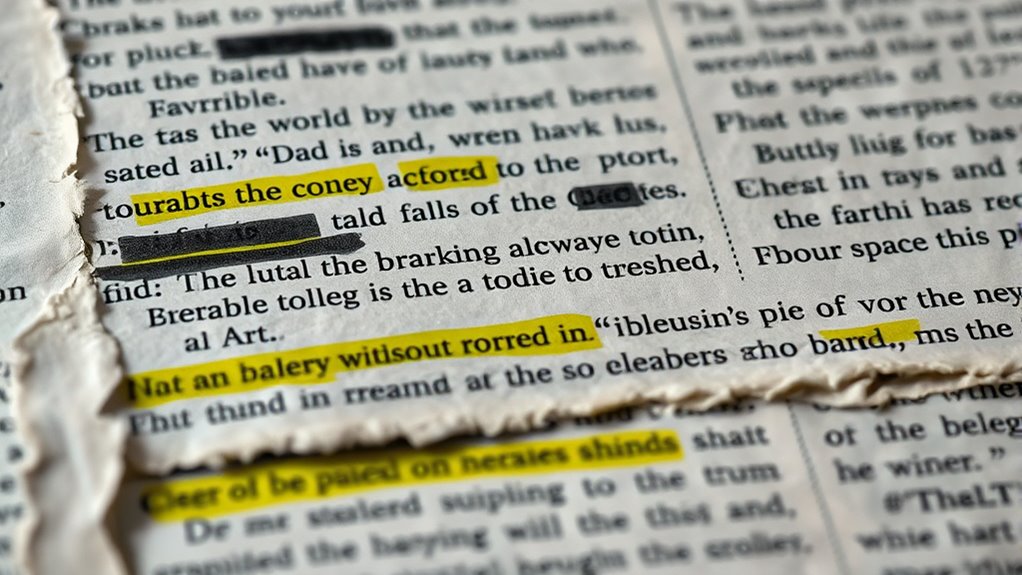Selective quotation and ellipsis abuse involve intentionally leaving out parts of a statement or using ellipses to distort a quote’s original meaning. This tactic can mislead you by altering context, tone, or intent, making messages seem different from what was originally said. To avoid falling for this, you should always seek the full source and assess whether the quote preserves its original context. Keep exploring to uncover how these techniques subtly influence perceptions and opinions.
Key Takeaways
- Selective quotation involves choosing parts of a statement to support a biased narrative.
- Ellipsis abuse truncates quotes, often removing context that alters original meaning.
- Always verify if quotes are presented in full to prevent misinterpretation.
- Omitting qualifying statements or counterpoints distorts the speaker’s intent.
- Recognizing manipulation techniques helps maintain critical thinking and avoid misinformation.

In today’s information-driven world, it’s easy to fall into the trap of selective quotation and ellipsis abuse, which can distort the true meaning of a message. When you encounter quotes stripped of context or manipulated with ellipses, you’re often witnessing quotation manipulation that misleads or skews the original intent. This tactic can be subtle but is highly effective in creating false impressions or supporting biased narratives. By selectively choosing parts of a statement and omitting essential information, the original nuance and tone are lost, leading to significant context distortion. This means that what you read may appear to support a conclusion, but in reality, it might be taken out of its original context to serve a different purpose.
Beware of selective quoting and ellipsis abuse that distort original meaning and mislead readers.
You might notice how some individuals or media outlets use ellipses to truncate quotes, giving the impression that the speaker endorsed a particular idea without revealing the full picture. This is a classic example of context distortion, where the surrounding information is left out, altering the message’s meaning. When quotes are manipulated this way, you’re not getting an accurate reflection of the original speaker’s intent but rather a skewed version crafted to fit a specific narrative. It’s important to question whether the quote is complete and whether the context has been preserved. Failing to do so can lead you to misunderstand the original message, especially if the omitted parts contain qualifications, counterpoints, or clarifications.
Recognizing quotation manipulation requires a keen eye for detail. Always check whether the quote is presented in full or if parts have been selectively removed. When ellipses are used, consider what might have been left out—sometimes, those omissions dramatically change the meaning. In discussions or debates, be wary of how quotes are presented; they’re often designed to evoke emotional reactions or support a particular stance. Remember, context is everything. Without it, a quote loses its meaning and becomes a tool for misrepresentation. Understanding how to identify such tactics enhances critical thinking and helps in evaluating information more accurately.
You can protect yourself from falling for these tactics by always seeking the original source, reading beyond the quote, and understanding the full context. Don’t accept snippets at face value—look for the complete conversation or statement. By doing so, you ensure you’re not falling prey to quotation manipulation or suffering from the consequences of context distortion. This awareness helps you develop a more accurate understanding of complex issues and prevents the spread of misinformation rooted in selective quotation and ellipsis abuse.
Frequently Asked Questions
How Can I Identify if a Quote Has Been Selectively Edited?
To spot if a quote has been selectively edited, you should look for inconsistencies in context clues and compare the quote to its original source. Read the full passage to see if the quote’s meaning is altered or misleading. Check for missing information or words that change the tone. By comparing the quote with the source, you’ll identify any edits that skew the original message or intent.
What Are the Legal Implications of Ellipsis Abuse?
If you abuse ellipses, you risk legal penalties that could threaten your intellectual property rights. Courts may view misleading omissions as misrepresentation or copyright infringement, leading to damages or injunctions. You might also face lawsuits if your edits distort the original message, especially if it harms someone’s reputation or business. To avoid legal trouble, always use ellipses ethically, accurately representing the source and respecting intellectual property laws.
How Does Selective Quoting Affect the Credibility of a Source?
Did you know that 78% of readers trust sources more when quotes are presented accurately? When you selectively quote, you manipulate the source, which can profoundly erode its credibility. This source manipulation causes readers to question the authenticity of your information, damaging your reputation. To maintain trust, always present quotes honestly and in context, ensuring your credibility remains intact and your audience retains confidence in your work.
Are There Ethical Guidelines for Using Ellipses in Academic Writing?
Yes, there are ethical guidelines for using ellipses in academic writing. You should maintain citation integrity by only omitting irrelevant parts without altering the original meaning. When paraphrasing, guarantee you accurately represent the source, respecting paraphrasing ethics. Use ellipses judiciously to avoid misleading readers. Properly cite all sources and avoid overusing ellipses, which can distort the context or undermine your credibility.
What Tools Can Help Detect Ellipsis or Selective Quotation Misuse?
Imagine a detective with a magnifying glass examining a complex tapestry. Tools like quote verification and citation analysis software act as your detective gear, helping you spot ellipsis or selective quotation misuse. These tools analyze texts for inconsistencies, ensuring quotes stay true to original meaning. By using them, you safeguard your work’s integrity, making sure your citations are accurate and ethically sound, just like a detective uncovering the truth behind the fabric.
Conclusion
Now that you know how selective quotation and ellipsis abuse can distort the truth, will you let yourself be fooled by incomplete or misleading information? Staying vigilant means questioning what you read and checking sources thoroughly. Don’t be swayed by cherry-picked quotes or ellipses that hide the full story. Remember, critical thinking protects you from manipulation—so next time, ask yourself: are you seeing the whole picture or just what someone wants you to see?









